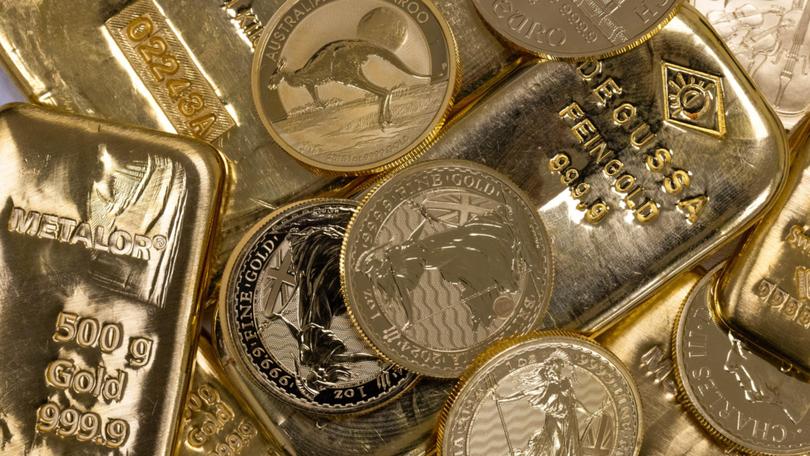How to start investing in gold and whether it’s worth it

Gold has been coveted for thousands of years, with its beauty, versatility and reputation as a safe haven making it hard to resist. From bars of bullion to mining stocks and ETFs, there’s myriad ways to get involved.
But has gold historically been a good investment? CNBC Pro takes a look at the pros and cons of investing in gold, where you can put your money — and the potential risks involved.
“It’s a beautiful-looking thing — people like to own it,” said Tom Price, research analyst at Panmure Liberum, said.
Sign up to The Nightly's newsletters.
Get the first look at the digital newspaper, curated daily stories and breaking headlines delivered to your inbox.
By continuing you agree to our Terms and Privacy Policy.Unlike other precious metals, gold doesn’t oxidize and is stable at room temperature, Price said, plus it has the same properties regardless of where it is extracted. “Portable, divisible, fungible and stable are almost defining characteristics of a primordial currency, and so that’s why gold carries this value.”
Gold prices have also been on a stellar run of late, rising 13 per cent in 2023 and up more than 17 per cent year-to-date as of mid-July amid high geopolitical tensions, a ramp-up in central bank buying, and expectations of interest rate cuts in the US.
New York spot prices have been trading at around $US2465 an ounce and analysts are bullish looking ahead. Both Bank of America and Citi strategists say the price of gold could reach $US3000 an ounce within the next 18 months.
‘Store of value’
Gold’s role as a “store of value” comes into its own for many investors when markets become volatile.
It’s an “effective hedge against fears of geopolitical polarisation, inflation, or excessive deficits,” according to UBS, while Berenberg notes that gold is “still preferred in volatile markets”.
When investing for the long term, “Why not have some gold?” asks Robin Bhar, an independent commodities consultant. “You don’t know what the world will look like in 15, 20 years’ time, and having some gold may pay you dividends — or it may not.”
Gold is also often considered to be a hedge against both the dollar and inflation.
As gold is often priced in US dollars, it tends to have an inverse relationship to the currency (although this is not always the case). And when it comes to inflation, the World Gold Council says the metal’s gains have outpaced consumer price indices since the 1970s. “In years when inflation was between 2 and 5 per cent, gold’s price increased 8 per cent per year on average,” the industry trade association said.
As a long-term inflation hedge, gold has performed well, according to Amy Arnott, a portfolio strategist at Morningstar. But over shorter periods, its record is more “mixed”, she said, pointing to historical fluctuations.
“Gold did excel during the high inflationary period of the 1970s, when surging oil prices and a rapidly expanding monetary supply pushed inflation to historically high levels in the United States. But in other periods, such as the early 1980s and 1988-91, it actually posted negative total returns, on average, and lagged large-cap stocks by a wide margin,” she said.
Some investors have pointed out that other investments — such as Treasury inflation-protected securities, for example – offer better ways of protecting against rising prices.
In certain crises, investors can expect gold prices to fall, according to John Meyer, head of research at corporate finance firm SP Angel, but they will “generally recover faster than other investments giving investors a greater degree of protection than many other instruments,” he said.
How to invest
Investors should consider holding around 2 per cent of their portfolio in gold, according to the market experts who spoke to CNBC Pro, although they said this might be worth increasing depending on one’s perception of the global outlook. Between 5 and 10 per cent is generally recommended as the upper limit of allocation to gold, with many viewing it as a key way of diversifying a portfolio.
There are several ways to get exposure to gold, including investing in the physical product, buying gold-related stocks such as mining companies, or choosing exchange traded funds.
Owning gold coins or bars has a certain cache for some — and there are benefits of buying the physical product, especially if you’re particularly nervous about geopolitical events and the macroeconomic outlook, according to Price. For some people, “all they want to do is own the actual metal, because they have a very specific reason, it’s about inflation protection, end of the world protection, that sort of thing.”
There are sometimes significant tax implications to consider, however.
UK investors are lucky, with bullion coins from UK’s Royal Mint exempt from capital gains tax, a levy charged on profit made when goods are sold, and free of value-added tax (or VAT, usually 20 per cent). In the US, however, gold is classed as a collectible, and both the physical bars and ETFs attract up to 28 per cent capital gains tax.
Gold ETFs
If you don’t want to hold — and be responsible for storing — gold bullion yourself, buying into an ETF that physically holds gold is another way of investing. “It’s actually pretty simple,” according to Colin Hamilton, commodities analyst at BMO Capital Markets. “You own the physical material, but you don’t have it in your hand,” he said.
The SPDR Gold Shares ETF is the world’s largest, with BlackRock’s iShares Gold Trust and iShares Physical Gold ETC the second and third, respectively.
Other top physical gold ETFs include the Borse Commodities GmbH Xetra-Gold and the SPDR Gold MiniShares Trust.
Gold mining ETFs
Buying gold mining ETFs — which own shares of multiple gold mining companies — is another way to get exposure to gold, and Meyer described those backed by large banks as “relatively safe”.
Some of the world’s top ETFs include the VanEck Gold Miners ETF and the VanEck Junior Gold Miners ETF, which invests in smaller companies that may be involved in exploration.
Other top ETFs include the iShares Gold Producers UCITS ETF USD, VanEck Gold Miners UCITS ETF Accum A USD and iShares S&P/TSX Global Gold Index ETF.
Single stocks
For those interested in buying single stocks, Meyer said he expects Barrick Gold and Newmont Mining to “continue to perform,” and also picked Resolute Mining, Centamin, Hochschild Mining and Caledonia Mining. ”[They] all look like respectable and worthy companies,” he said.
Equities or physical gold?
Owning mining ETFs and stocks gives investors exposure to gold prices, with shares tending to rise in tandem with the metal, without being so directly tied to the physical metal’s price fluctuations.
However, Price said this can also have negative implications, with gold-related stocks “famously” underperforming the price of the metal itself. “Even though gold equities respond to changes in gold price, the degree of that response has deteriorated over time,” he said, adding that the risks and costs of gold extraction can weigh on miners.
George Milling-Stanley, chief gold strategist at State Street Global Advisors, which runs the physical-gold-holding SPDR Gold Shares ETF, agrees.
“One of the reasons I own gold bar(s) is that I believe it offers me some protection against potential weakness in the equity market,” he said.
“When the equity market goes down, gold mining stocks remember that they’re equities, and they tend to go down with the general level of the equity market. So, they’re not offering me that extra level of protection.”
Risks
Despite its safe-haven reputation, investing in gold is not risk-free. Prices can be volatile, reacting to breaking news, and dynamics in the physical market — like supply and demand — can also come into play.
Investors should also consider whether other investments could offer greater returns over the long term.
Over the past five years, for instance, gold returned 10.59 per cent compared to a 15.05 per cent return for the S&P 500 stock market index, per Morningstar Direct. This is “well above” the long-term average, Morningstar’s Arnott said. Over the past 50 years, gold returned 5.72 per cent compared to the S&P 500′s 11.75 per cent.
Another issue with physical gold in particular is that it doesn’t offer interest or dividends, unlike many other asset classes such as stocks and bonds.
When asked whether investing in gold is worth it, Bhar said it’s a “difficult” question, but conceded: “If we keep it simple, I think the answer has to be ‘yes’.”
″[If] you’re even slightly risk averse, or … like us you’re bearish on gold, we would still recommend to people to own a little bit of gold in their portfolio, because it offers, sort of, extreme scenario protection,” Price added. “After war is resolved … gold is still a good place to be.”
CNBC
